The Story
As kids growing up in Wauwatosa, we had two parents and four grandparents who, among many other things, served as our personal and familiar connection points with our family history. Indeed, at least for me, they were our family's history. I do have vague memories of mom's eyes lighting up when she would launch into some story with a "Holy Hill" connection, as she seemed to use Holy Hill as a her reference 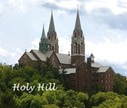 point for situating people and events in her past. And I remember the predictable ritual in which mom would instruct all of us kids to look into the woods for evidence of a decaying log cabin, presumably occupied by one of her ancestors, as dad sped down the two-lane back highway on our annual trip to the gathering of the Shinners clan on Pike Lake. I also recall, but even more vaguely, dad occasionally referring to names like "Aunt Charlotte", "Uncle Ollie", and "Daisy", but these were not people I knew. In retrospect, it seems that my limited curiosity at the time led me to miss these opportunities to learn more about the branches of our family tree that stretched back further than our grandparents. We were the Shinners and Larkins, and that was enough for me.
point for situating people and events in her past. And I remember the predictable ritual in which mom would instruct all of us kids to look into the woods for evidence of a decaying log cabin, presumably occupied by one of her ancestors, as dad sped down the two-lane back highway on our annual trip to the gathering of the Shinners clan on Pike Lake. I also recall, but even more vaguely, dad occasionally referring to names like "Aunt Charlotte", "Uncle Ollie", and "Daisy", but these were not people I knew. In retrospect, it seems that my limited curiosity at the time led me to miss these opportunities to learn more about the branches of our family tree that stretched back further than our grandparents. We were the Shinners and Larkins, and that was enough for me.
Many decades would pass before I finally would begin to wonder about the earlier generations in our family story. (In fact, I write 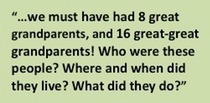 these words on my 59th birthday, and I suspect that aging is not unrelated to my sudden curiosity about our place in the larger scheme of things.) If we had 2 parents and 4 grandparents, then we must have had 8 great grandparents, and 16 great-great grandparents! Who were these people? Where and when did they live? What did they do?
these words on my 59th birthday, and I suspect that aging is not unrelated to my sudden curiosity about our place in the larger scheme of things.) If we had 2 parents and 4 grandparents, then we must have had 8 great grandparents, and 16 great-great grandparents! Who were these people? Where and when did they live? What did they do?
In the limited ancestry research that I have had time to devote to these questions, I have been able to find only "bare bones" factual information about our more distant relatives. However, even being able to give actual names to these relatives, and to locate them in specific places during particular time periods, has for me been a fascinating exercise. One that has motivated me to want to share this information with the rest of my family.
In the "Brief Family Sketches" section of this web site, I provide what information I have on each of the 15 families (60 individuals) that preceded us in our family tree, going back to our great-great grandparents' generation. However, in this section I step back from those individual family stories to offer some summary observations on the themes or patterns in these families' lives that might provide us with a more holistic understanding of the various roads that, for us, converged on 69th Street in Wauwatosa.
Immigration to America
The land mass that is the United States has been receiving a steady stream of immigrants from all over the world for more than 400 years. So, at least theoretically, locating the arrival of our own ancestors could begin with a pretty wide canvas. Of course, the search is narrowed considerably by the fore-knowledge that our relatives probably didn't come from Africa in the galleys of a slave ship, nor from China through Angel Island in San Francisco Bay, nor from Spain up through the ranchos of Mexico or Texas. No, we know from family oral history that our kin were Irish/English, so we could be reasonably confident that their arrival was at some port on the eastern coast. However, if that narrows the "where", it does little to specify the "when". Given the fact that, as kids, we were never impressed with stories of our deep lineage in the US, which seems to be a practice in families that descended from early settlers, we could probably dismiss the first couple centuries and look for our relatives in the more recent immigration from the English/Irish region of Europe. Still, immigrants from northern and western Europe poured into the US by the millions throughout the 19th Century. Our ancestors could have trickled over and been dispersed anywhere among those masses.
Now, I frame this discussion of our ancestors' immigration to America in these very broad terms in order to accent or highlight what struck me as a remarkable finding about the actual immigration experiences of our relatives. I noted in the Introduction section of this web site that my goal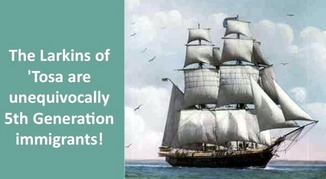 was to locate our ancestors who had emigrated from Europe to the US, and to "begin" our story with them. What I found was that that immigration occurred entirely within our great-great grandparents' generation. Or, put another way, all 16 of our great-great grandparents were born in Europe, and all 16 of them died in the United States. Thus, the Larkins of 'Tosa are unequivocally 5th Generation immigrants!
was to locate our ancestors who had emigrated from Europe to the US, and to "begin" our story with them. What I found was that that immigration occurred entirely within our great-great grandparents' generation. Or, put another way, all 16 of our great-great grandparents were born in Europe, and all 16 of them died in the United States. Thus, the Larkins of 'Tosa are unequivocally 5th Generation immigrants!
But, the story is more interesting than that. Almost all of them came to America in the very narrow timeframe from the early-1840s to the early-1850s. There are only two exceptions to this pattern. One of our great-great grandfathers, John Whalen, emigrated from Ireland to Boston as a child with his parents in the 1820s, and great-great grandparents William and Eliza Watts and their daughter Emma emigrated from England to the US in the 1860s. In the latter case, quite charmingly, ship records list the Watts family's final destination as "Mill Wokey"!
I don't have any information that might help us understand the personal reasons that these 16 individuals had for nearly simultaneously deciding to emigrate to America, but the political and economic conditions on the island of Ireland in the 1840s make it pretty easy to guess. At that time,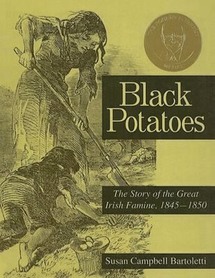 Ireland was under the occupation of British forces, most of its agricultural land had been taken over by English landlords, the Irish people were being subjected to severe political, social, and economic oppression, and Irish revolts against these conditions were constantly recurring events. In short, Ireland was in the midst of a particularly violent form of a condition that has persisted in varying ways and degrees from roughly the dawn of time up to the present day! (I've had the opportunity to personally witness British armored trucks "keeping order" in the Catholic section of west Belfast in Northern Ireland.) Then, on top of these conditions, add the devastating Potato Famine in which roughly 1,000,000 Irish died from starvation and disease, and it doesn't take much imagination to understand why an estimated 2,000,000 people (nearly 1/4th the population) chose to leave Ireland between 1845 and 1855.
Ireland was under the occupation of British forces, most of its agricultural land had been taken over by English landlords, the Irish people were being subjected to severe political, social, and economic oppression, and Irish revolts against these conditions were constantly recurring events. In short, Ireland was in the midst of a particularly violent form of a condition that has persisted in varying ways and degrees from roughly the dawn of time up to the present day! (I've had the opportunity to personally witness British armored trucks "keeping order" in the Catholic section of west Belfast in Northern Ireland.) Then, on top of these conditions, add the devastating Potato Famine in which roughly 1,000,000 Irish died from starvation and disease, and it doesn't take much imagination to understand why an estimated 2,000,000 people (nearly 1/4th the population) chose to leave Ireland between 1845 and 1855.
Whatever their reasons, most of our ancestors did choose to undertake the enormous challenges that came with relocating to another continent in the 1840s. In a few cases, individual great-great grandparents made the immigration decision, then met and married one another in the US. However, although it isn't always clear, it seems more common that they were married in their native country, and then together decided on immigration. In any case, it is clear that our great-great grandparents began leaving paper trails in the US in the 1840s, so our family story in America began about 160 years ago.
Just How Irish Are We?
As I began inquiring into the national origins of the members of the immigrant generation in our family tree, I was reminded of a sense of dissonance that I used to harbor about our ethnic heritage as a kid growing up in Wauwatosa. This discomfort (which was only minimal) arose from two thoughts or feelings that I had at the time. The first thought was that I 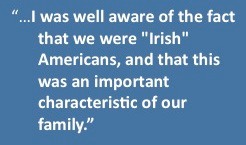 was well aware of the fact that we were "Irish" Americans, and that this was an important characteristic of our family. It wasn't that it was important in any practical sense, for there was nothing that was particularly Irish about how we lived. But it did seem to have some kind of symbolic significance that helped to define us and to connect us to other people, places, and events. Moreover, I was proud of being Irish. I'm sure that I couldn't have offered any reasons for this pride, but I did realize that when people were divided into "those who were Irish, and those who wished they were," the Larkin family was lucky to be on the right side of that divide.
was well aware of the fact that we were "Irish" Americans, and that this was an important characteristic of our family. It wasn't that it was important in any practical sense, for there was nothing that was particularly Irish about how we lived. But it did seem to have some kind of symbolic significance that helped to define us and to connect us to other people, places, and events. Moreover, I was proud of being Irish. I'm sure that I couldn't have offered any reasons for this pride, but I did realize that when people were divided into "those who were Irish, and those who wished they were," the Larkin family was lucky to be on the right side of that divide.
The second thought I remember having about our ethnic heritage was that my first thought might not be true. That is, I suspected that we might not really be 100% Irish. While I can't say that I remember anyone ever insisting that we were fully Irish, I was aware at the time that no other possibility was ever mentioned. Yet, we knew that Granny Larkin's birth name was Marsh, and that never struck me as very Irish. Moreover, this suspicion was reinforced by the fact that dad's side of the family never seemed to engage in the kinds of Irish anecdotes and blarney that were so common on mom's side. And these things made me wonder.
In the end, because I really didn't want to be anything less than 100% Irish, I believe that I simply dismissed the possibility as a mere technicality. A potentially small glitch that had no real importance. After all, if mom's values and style and world view could set the tone for our household, then certainly she could establish her fully Irish heritage as ours, as well. As if transmitting values and genes between the generations occurred in pretty much the same way!
In its most simplistic form, the answer is that the Larkins of 'Tosa are 75% Irish and 25% English. Of our 16 great-great grandparents, 12 emigrated from Ireland, and the other 4 came from England. On mom's side of the family, the question of ethnic heritage is rather clear and unambiguous. All 8 great-great 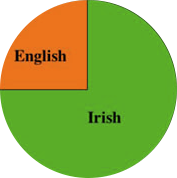 grandparents on that branch of our tree were born and raised in Ireland, and they married each other. Thus, the four children they produced who would later marry (our great-grandparents), and later their two children who would marry (Joe Shinners and Elizabeth Flynn Shinners), and still later their daughter (mom), were all thoroughly Irish Americans.
grandparents on that branch of our tree were born and raised in Ireland, and they married each other. Thus, the four children they produced who would later marry (our great-grandparents), and later their two children who would marry (Joe Shinners and Elizabeth Flynn Shinners), and still later their daughter (mom), were all thoroughly Irish Americans.
Dad's contribution to our ethnicity is only slightly more complicated. We know that four of the great-great grandparents on that branch did emigrate from Ireland (Grandpa Larkin's ancestors) and four did emigrate from England (Granny Larkin's ancestors). So, we know that dad was 50% Irish and 50% English. And when you pair this with mom's 100% Irish, you arrive at our own 75/25 split.
Where in Ireland?
Identifying more specific locations within Ireland and England in which our relatives lived prior to immigration is an area in which I have had little luck in my own research. However, a number of the family histories that were included in the 150th Anniversary of Erin Township, which I referred to in the Introduction section of this web site, did provide this information for about 6 of our 8 great-great grandparents on mom's side of the family. So, as I tend to trust these family histories, I pass on their information. These reported that two of our ancestors came from Listowel Parish in County Kerry, two lived in County Limerick, one in County Cork, and one came to America from the Aran Islands off the western coast of Galway. (Click on the map for an enlarged version.)
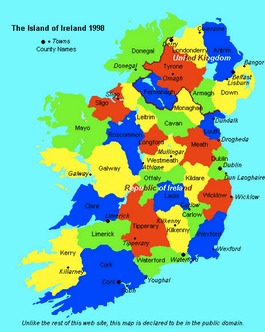
On dad's side of the tree, my own inquiries also came up dry. However, Liz Ault, a member of the extended Larkin clan who displayed some of her own genealogy research in Ancestry.com, seems to believe that two of dad's Irish ancestors came from County Carlow. While I do not know the source of this information and cannot confirm it, I pass it on as a possibility.
Now, with at least some knowledge of when and from whence our family tree stretched across the Atlantic from Europe to America, we can turn our attention to the branches of that tree as they wind their way toward 'Tosa.
The Two Roads to 'Tosa
European immigrants arriving in American ports in the middle of the 19th Century, in the main, poured into the emerging urban-industrial centers on the east coast in search of the factory and entrepreneurial opportunities that were widely advertised back home. And it was during this era that such places as New York, Boston, Baltimore, and Philadelphia began to take on their modern shape and form as major American cities. However, some of the immigrants at this time, far fewer but still significant in number, chose to bypass this obvious option, and instead to push on even further to take advantage of the labor opportunities or the reported vast expanses of cheap land that were available in the hinterlands that we now call the Midwest.
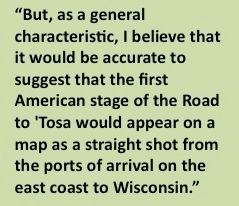 For the most part, our great-great grandparents were members of this minority who decided to head west rather than hang around on the east coast. Although, there were exceptions to this pattern. One pair of relatives on mom's side did spend several years as youths in Boston before leaving the east, and a couple families on dad's side spent at least a few years at various locations out east before realizing that it would be far better for their descendants to become Brewer fans than end up cheering for the Yankees. But, as a general characteristic, I believe that it would be accurate to suggest that the first American stage of the Road to 'Tosa would appear on a map as a straight shot from the ports of arrival on the east coast to Wisconsin.
For the most part, our great-great grandparents were members of this minority who decided to head west rather than hang around on the east coast. Although, there were exceptions to this pattern. One pair of relatives on mom's side did spend several years as youths in Boston before leaving the east, and a couple families on dad's side spent at least a few years at various locations out east before realizing that it would be far better for their descendants to become Brewer fans than end up cheering for the Yankees. But, as a general characteristic, I believe that it would be accurate to suggest that the first American stage of the Road to 'Tosa would appear on a map as a straight shot from the ports of arrival on the east coast to Wisconsin.
Over the decade of the 1840s, most of our immigrant ancestors began to arrive in Wisconsin. By the end of the 1840s, 12 of our 16 great-great grandparents had settled in Wisconsin, many before Wisconsin even became a state in 1848. So, if any of you are so inclined, our family is legitimately entitled to develop some "old settler" yarns of our own, using Wisconsin, if not the US, as a context. However, once in Wisconsin, the two major branches of our family tree headed in different directions, so it might be helpful to discuss these Two Roads to 'Tosa separately.
Mom's Branch: Farmers of Rural Erin
When I began browsing through the 150th Anniversary of Erin Township, I did so because we grew up knowing that the Shinners clan came from Erin, just 30 miles or so northwest of our home in 'Tosa. And, I was curious to learn something about them. But, rather quickly, I started to learn things that I really had not thought much about up to that point. (I would later confirm most of these lessons through my own independent research.) The first, and for me the most interesting, is that the Erin blood that feeds our ancestral tree did not all come from Grandpa and Grandma Shinners. Indeed, to the extent that we feel some affiliation with "names" simply because they belonged to our early relatives, I discovered that we have direct family connections to great-great grandparents whose names were Garvey, Cahill, Whalen, Hennessey, Belson, Wallis, and yes, Flynn and Shinners.
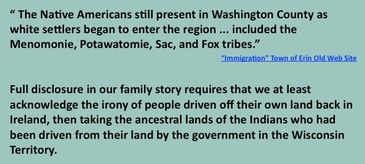 Secondly, I learned that all 8 members of the 1st generation immigrants in this branch had settled as the first white pioneers in Erin, both temporarily co-existing with and displacing the native peoples who had resided there for longer than most of us are able to comprehend.
Secondly, I learned that all 8 members of the 1st generation immigrants in this branch had settled as the first white pioneers in Erin, both temporarily co-existing with and displacing the native peoples who had resided there for longer than most of us are able to comprehend.
The Irish immigrants who landed in Erin Township in the 1840s and '50s were actively recruited by government officials and private land agents with offers of inexpensive land and other economic opportunities. To learn more about this process, you might wish to take a look at a popular book of the era entitled The emigrant's hand book, and guide to Wisconsin : comprising information respecting agricultural and manufacturing employment, wages, climate, population &c; sketch of Milwaukee …
I would also learn that all four families in our second generation (our great grandparents) on this side of the tree would also live their lives in Erin. Thus, from the 1840s until about 1900, the first two generations of this branch would occur entirely within the 6-mile square Town of Erin, a town that shares its southern border with Waukesha County where four of the five Larkins of 'Tosa currently reside!
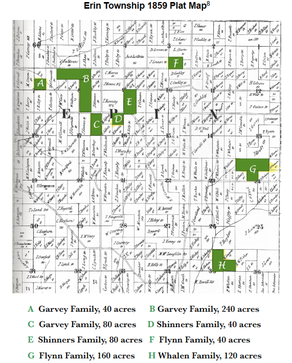
Finally, I would learn that all of our ancestors of Erin were land-owning farm families who were dispersed around the township. To the left is an Erin Township plat map from 1859. If you click on this map, you can discover where in Erin most of our ancestors farmed, and how may acres they owned. One source I read indicated that land in Erin was selling (or being given away to attract European settlers) in the 1840s for about $1.50/acre, or $60 for the typical 40 acre farm. In today's economy, that would translate into a purchase of $1,188, for all 40 acres. While I haven't checked, I suspect that folks in Erin today have had a change of mind.
As families tend to grow geometrically with each succeeding generation, by the time the third generation of Erin came along it had been learned that there are real limits to just how far you can subdivide 36 square miles of farm land. So, many in this generation began moving to other locations. Among them was Joe Shinners, son of Thomas and Ellen Whalen Shinners, who by then lived on a rather small farm  immediately adjacent to the village of Monches. Whether he had to or wanted to leave the farming life and Erin I haven't a clue, but in approximately 1900-05 Grandpa Joe Shinners at about the age of 20 ended the Erin chapter in our story and moved to Milwaukee where he became a police officer. In 1906, he was joined in Milwaukee by his new wife, Elizabeth Flynn Shinners, daughter of John and Ellen Garvey Flynn, who had grown up on quite a large farm in Erin just a stones-throw from Holy Hill.
immediately adjacent to the village of Monches. Whether he had to or wanted to leave the farming life and Erin I haven't a clue, but in approximately 1900-05 Grandpa Joe Shinners at about the age of 20 ended the Erin chapter in our story and moved to Milwaukee where he became a police officer. In 1906, he was joined in Milwaukee by his new wife, Elizabeth Flynn Shinners, daughter of John and Ellen Garvey Flynn, who had grown up on quite a large farm in Erin just a stones-throw from Holy Hill.
If Grandpa and Grandma Shinners had left Erin and extended their branch of the road south to Milwaukee, they did not leave behind the farming penchant for large families. Indeed, in Milwaukee they would have ten children between 1907 and 1923. And, unabashedly, the most prominent among these would be their daughter Mary Margaret (1915), who would go on to great fame as the loving mother of the Larkins of 'Tosa. But, before we go there, let's give dad's family a chance to catch up with our story.
Dad's Branch: Craftsmen, Merchants, and City Life
Following the road traveled by our relatives on dad's side isn't quite as simple as finding them all nested in the same small, rural township, at least not initially. Once again, we do learn some new names that are embedded somewhere in our DNA, names like Gorman, Watts, and Mautle Marsh (there's a name for one of our future grandchildren!). But, the birth names of 4 of our 8 great-great grandparents on this branch remain hidden by marriage and incomplete records. We also learn that their pathways to Milwaukee, and how they made their livings, were somewhat more varied than in the Erin experience.
Three of the four married couples on dad's branch of the tree arrived in America at about the same time (early-1840 to early-1850s) as mom's ancestors, but their next moves were different. Mautle and Elizabeth Marsh, from England, seem to have taken a straight shot to Milwaukee, probably arriving some time before 1847. They became our first relatives to 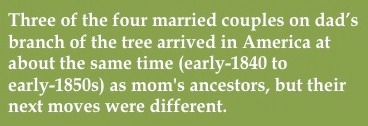 inhabit the Brew City, more than a half-century before the other branch of our family tree. By comparison, Elizabeth Gorman and her husband (his first name and her birth name remain a mystery), who arrived from Ireland at roughly the same time, then spent several years living and producing a couple kids somewhere in New York before making the final trip to Milwaukee in the 1860s.
inhabit the Brew City, more than a half-century before the other branch of our family tree. By comparison, Elizabeth Gorman and her husband (his first name and her birth name remain a mystery), who arrived from Ireland at roughly the same time, then spent several years living and producing a couple kids somewhere in New York before making the final trip to Milwaukee in the 1860s.
James and Mary Larkin had still another plan. Immigrating from Ireland to the US in the early 1840s, they then jumped around out east from Connecticut to New York to Massachusetts for a number of years, having children at each stop. In fact, we can reasonably blame great-great grandfather James Larkin for using up the entire supply of adventure travel genes before passing the gene pool in dad's direction. Eventually, they would hear the call of the midwest, but there were still more stops to make. By 1850, they were living in Lebanon, in Dodge County, Wisconsin, where they stopped long enough to have a child they called Francis, who much later would become dad's grandfather. The next stop was in Watertown, in Jefferson County, Wisconsin, where they appear to have stayed through the 1860s and perhaps longer. I can't determine if he went with his family or alone, but we do know that son Francis traveled the final leg of this circuitous journey and was set up in Milwaukee by the mid-1870s.
The fourth couple in this immigrant generation, William and Eliza Watts, got a much later start than the others, not leaving England until 1868. Fortunately, realizing their late start, they were wise enough to include in the possessions they brought with them a nearly-grown daughter named Emma. Emma is the only one of our 8 great-grandparents on either side of the family who was not born in the United States. Emma would also become Granny Larkin's mom. Arriving in the Port of New York in the fall of '68, my guess is that the Watts family wasted little time in continuing their trip to their stated final destination of "Mill Wokey".
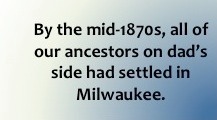 By the mid-1870s, all of the varied pathways of the immigrant generation on dad's side of the story had converged in Milwaukee, Wisconsin. The sketch below shows that this Milwaukee in the 1870s was already a fairly substantial town, but the excitement was just beginning. Over the next couple decades, a rapid expansion in manufacturing and massive explosion in new immigration, only a small portion of whom looked or talked like our Yankee or Irish relatives, would drive the population in this metropolis from about 60,000 to more than 200,000 people by 1890. And that number would nearly triple again to 587,000 by 1940. It was in this context that the second and third generations of this branch of our family tree would live out their lives.
By the mid-1870s, all of the varied pathways of the immigrant generation on dad's side of the story had converged in Milwaukee, Wisconsin. The sketch below shows that this Milwaukee in the 1870s was already a fairly substantial town, but the excitement was just beginning. Over the next couple decades, a rapid expansion in manufacturing and massive explosion in new immigration, only a small portion of whom looked or talked like our Yankee or Irish relatives, would drive the population in this metropolis from about 60,000 to more than 200,000 people by 1890. And that number would nearly triple again to 587,000 by 1940. It was in this context that the second and third generations of this branch of our family tree would live out their lives.
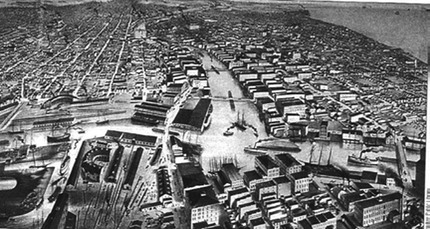
As we might imagine, even in these early days, Milwaukee did have an eastside, a southside, a westside, and a northside, and these sectors offered new immigrants plenty of options on where to live. So, it's rather interesting that all of our ancestors seem to have been thinking along similar lines. In fact, as near as I am able to determine from the available information, all of them seemed to live in an area roughly bounded by the Milwaukee River on the east and about 27th St. on the west, and within several blocks north or south of Wisconsin Ave. So, if I'm correct, these disparate immigrants and their kids settled in an area that was only a fraction of the size of Erin Township. It's also interesting, and of more than just a little importance to us, that it would be within this same central Milwaukee district that Joe and Liz Shinners would choose to set up their home when they moved down from Erin.
The historical records that I had access to provide at least some insights into how these ancestors made a living. If any of the women worked outside the home, it's hard to tell. Often, forms asked only for the husband's work. And, in virtually every case in which some information was offered, some variation on "housewife" or "keeping house" was provided.  One exception to this was when great-great grandmother Elizabeth Gorman, by then a widow, identified herself as a "tailores" (sic) on an 1870 census form. As for the males in this first generation, "blacksmith", "shoemaker", and "master carpenter" or later "builder" are the designated occupations. Thus, it would appear that our early relatives were grounded in the skilled trades, but that none was working in the professional fields of their day.
One exception to this was when great-great grandmother Elizabeth Gorman, by then a widow, identified herself as a "tailores" (sic) on an 1870 census form. As for the males in this first generation, "blacksmith", "shoemaker", and "master carpenter" or later "builder" are the designated occupations. Thus, it would appear that our early relatives were grounded in the skilled trades, but that none was working in the professional fields of their day.
Not long after arriving in Milwaukee, the children of the original immigrants on dad’s side began meeting and marrying one another. Francis Larkin who had come in from Watertown, and who was now old enough to call himself Frank R. Larkin, married Catherine Gorman who had moved with her mom from New York. At about the same time, roughly the late 1870s, Emma Watts who had come late from England with her parents tied the knot with Robert Marsh whose parents had been in Milwaukee for a long time. It seems that Robert Marsh was a "contractor" who worked out of 770 Racine St. (wherever that is), and later in life as a "superintendent in a chair factory." Frank R. Larkin identified himself at different points as a "reporter in a commercial agency", a "merchant", and as an "assistant manager" with the R. G. Dunn Co. But more than just that, Frank R. was also designated (was it self-designation like today's Who's Who?) as a member of Milwaukee's Elite in 1891-92.
In browsing the records for these two new Marsh and Larkin families, the information I found was, for me anyway, quite surprising. Stretching from the late-1870s through the 1890s, the Marsh family produced 5 children and the Larkins had 9 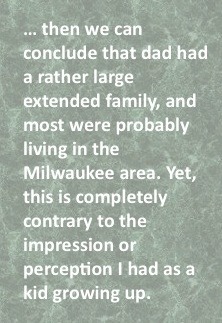 kids. Now, if we subtract the two among these that will become our dad's mother and father, that means that the remaining 12 would become dad’s aunts and uncles. And, if we then assume that some of these aunts and uncles will marry and have kids, then we can conclude that dad had a rather large extended family, and most were probably living in the Milwaukee area. Yet, this is completely contrary to the impression or perception I had as a kid growing up. Beyond dad's one brother (Uncle Bob) and his family, the discussions about or interactions with dad's wider family that I remember during our years in 'Tosa were minimal. And this led me to believe that dad simply came from a small family, both immediate and extended. However, that turns out not to have been the case.
kids. Now, if we subtract the two among these that will become our dad's mother and father, that means that the remaining 12 would become dad’s aunts and uncles. And, if we then assume that some of these aunts and uncles will marry and have kids, then we can conclude that dad had a rather large extended family, and most were probably living in the Milwaukee area. Yet, this is completely contrary to the impression or perception I had as a kid growing up. Beyond dad's one brother (Uncle Bob) and his family, the discussions about or interactions with dad's wider family that I remember during our years in 'Tosa were minimal. And this led me to believe that dad simply came from a small family, both immediate and extended. However, that turns out not to have been the case.
Having said that, in 1908 or 1909 a highly improbable event occurred in the early life of our family. Frank R. and Catherine Larkin's son, Frank J., met and married Robert and Emma Watts' daughter, Mabel. In doing so, the young Frank J. not only married someone who descended from the dreaded English, but he married a young woman who almost certainly was a Protestant! We can only imagine the conversations that occurred around the kitchen tables in both homes leading up that union. However, as it seems that Grandma Mabel Larkin lived her adult life and died as a Catholic, I have to assume that she converted to this religion at some point. Whether she also converted to Irish is less clear. At any rate, the next time we're out, let's be sure to raise a glass to Granny and Boppy Larkin!
The Two Roads Merge!
In the few years preceding their marriage, Mabel Marsh appears to have worked as a stenographer; but, it looks like she gave up that job when she and Grandpa Frank married. He, on the other hand, continued to work most of his life in the wholesale shoe business, but the record is limited. All I could find was that in 1918 he worked for the Tomahawk Shoe Co, and by 1930 he listed himself as "Secretary of a shoe company." Still later, in the 1950s, he would get us discounts at the local shoe store on West North Ave. Early in their marriage, they would give birth to two sons, Robert (1910) and Franklin (1916), and the boys would spend their childhoods in the same central Milwaukee area where their parents and grandparents had lived.
Meanwhile, just blocks away, Joe and Elizabeth Shinners, who had moved into the 'hood as a couple in 1906, were vigorously populating their own family. It was noted above that Grandpa Joe had started a career as a police officer, but it's hard to say how long he stayed with that. By 1918, he was "self-employed" in the "cartage business" (Shinners Moving and Storage on what is now the Marquette University campus). Still later, he would serve two terms as Sheriff of Milwaukee County (1933-36 and 1941-44). In between these, he took a run at unseating long-time incumbent Socialist Mayor Daniel Hoan in a 1936 election that he narrowly lost, 111,167 to 95, 124 votes. The race even got some coverage in Time Magazine!
While Frank and Mabel Larkin had shown some moxy by breaking through the barriers of ethnicity and religion, they showed still more by being the first in our family line to leave the old neighborhood that had contained their families for decades. By 1930, they had moved with their two sons way out to 49th and Lloyd St. And, some time over the next decade, Joe and Liz Shinners and their crew would follow suit, moving to 53rd St., about five blocks away from Frank and Mabel Larkin.
I don't know when the Larkin's son, Frank (he was no longer Franklin, because like his father and his grandfather before him, and his first son after him, he had changed his original name), and the Shinners' daughter, Mary, actually met each other. It's possible, even likely, that they were aware of each other as early as elementary school. However, we do know that they knew each other in high school, as dad went to school and was friends with mom's brothers, and used to hangout over at their house. We also know that they went to Marquette University together in the late 1930s, where mom graduated with a degree in Social Work and dad earned a Law Degree. In so doing, they became the first generation in our family tree to earn a college degree. And, more importantly to our story, Frank and Mary fell in love!
Welcome to 'Tosa
With their marriage in 1941, mom and dad had a very brief opportunity to engage the professional 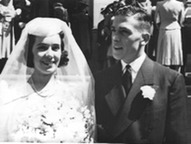 careers for which their college degrees had prepared them, mom working as a social worker (which she loved) and dad scrutinizing the fine print on legal forms in an insurance company (which he hated). Things changed fairly quickly, however, with the birth of their first child in 1942, and word that dad's application to the FBI was approved (which is why he went to law school). Then, to the particular surprise of a new mother, they were assigned to the San Francisco Bureau office as developments on the west coast were heating up in the early years of WWII, where they would live for nearly a year.
careers for which their college degrees had prepared them, mom working as a social worker (which she loved) and dad scrutinizing the fine print on legal forms in an insurance company (which he hated). Things changed fairly quickly, however, with the birth of their first child in 1942, and word that dad's application to the FBI was approved (which is why he went to law school). Then, to the particular surprise of a new mother, they were assigned to the San Francisco Bureau office as developments on the west coast were heating up in the early years of WWII, where they would live for nearly a year.
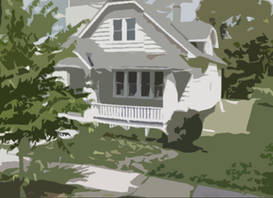
Upon their return to Milwaukee, they quickly learned that the WWII market for single-family homes was slim, and they would have to grab anything they could find. After some temporary rental living, they discovered that there was one available out in the suburb of Wauwatosa, a modest "Milwaukee bungalow" at 2262 N. 69th Street (pictured here), and that would have to do until the war ended and things returned to normal. So, in 1943, with one child in tow, mom and dad set up temporary quarters at the house in 'Tosa, where they would remain for more than 50 years!
Or, more meaningfully, they set up house within what would be designated as the St. Pius X Catholic Church parish boundaries. 'Tosa of the 1940s and '50s was a patchwork of Catholic parishes, and those parish boundaries gave us both our geographic bearings and our identities, not to mention our religious ceremonies, our schooling, and our friends.
All five of us grew up on 69th Street, in St. Pius Parish, in Wauwatosa. On the whole, ours was a home filled with love, support, security, and about a thousand pairs of wornout tennies. Indeed, the Larkins of ‘Tosa were dealt a most generous hand.
Eventually, of course, we would have to grow up, and one by one through the 1960s and '70s the kids of 'Tosa would begin laying new roads into our own adult lives. But, mom and dad, probably enjoying some of the new elbow room that becomes available in an empty nest, were not quite ready to leave their "temporary" home. So, 69th Street would remain the central locus and convening point for the Larkin family, including by then the 6th generation kids, for several more years.
Yet, in the late-1990s, reliving the lessons of Ireland, and Watertown, and Erin, and the central wards of Milwaukee, mom and dad would close the book on the 'Tosa chapter in our family story and move to an apartment complex for seniors in the suburb of Brookfield, nearer to where most of their kids were living. From Brookfield, on a bright and clear day, you can see the spires of Holy Hill Church as they reach high into the sky from their hilltop pearch in Erin Township some twenty miles to the north. There, in a place called Brookfield Manor, which dad enjoyed referring to as "Stalag 7", mom and dad would live out the few years remaining in their lives.
The End of this Chapter
I recount in this summary of our family's history no information on our lives in 'Tosa, nor on the several branches and sub-branches that have been added on to our family tree since those years came to an end. All of that is history that we already know because it is about our lives. So, I leave it to future generations to unearth the vital statistics and other details if and when they are so inclined. With things like divorces, remarriages and blended families, partnerships without marriage, step-children, adoptions, career changes, interstate relocations, and other contemporary complexities all reflected in our more recent family stories, it will be challenging for future genealogists, indeed!
And, all bets are that it will get even more complicated in the years ahead. As I look at our children (6th generation) and at our grandchildren (7th generation), whose stories are already unfolding, it seems to me that one or more of them will almost certainly make the decision to emigrate out of America in search of opportunities in some other parts of our shrinking world. If so, they will be carrying on the one tradition that has persisted over the generations of our ancestors. I trust that it will be an interesting extension to this story.